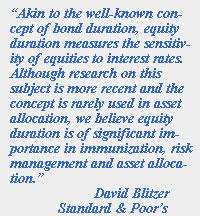





|
|
|
|
|
|
|
|
|
|
|
|
|
|
|
|
|
How do we ensure that there will be sufficient assets in a pension fund to pay for both current and future needs? What is needed is a flexible approach that allows plan sponsors to consider the timing of cash flows, the fiduciary responsibility to provide a reasonably diversified portfolio, and the necessity of earning a reasonable rate of return to minimize required contributions. We would like the reader to examine is a framework that combines aspects of traditional investment management with the concepts of asset-liability risk management.
Let’s start with immunization,
which as we have noted before is simply cash flow matching However, what if we are able to extend the concept of duration to include other investment instruments? We could then broaden the investment universe and thus overcome the diversification and return limitations of the duration matching immunization approach. Over the past few years, more and more literature has been published regarding the concept of “equity duration.” Since duration is simply a tool used to predict how bond prices move in response to interest rate changes, it would be useful to extend this concept to other types of securities. The problem lies in the fact that with most bonds, the cash flows are predictable – barring a catastrophe such as bankruptcy – while with other securities such as equities, the cash flows are uncertain. While this issue makes it more difficult to calculate equity duration, it does not detract from its utility in immunization, risk management, and asset allocation. Equity duration promises to be a significant new tool in the asset-liability management toolbox. (To read more about duration please see our "Articles & Resources" section.) While there continues to be considerable debate regarding the theoretical underpinnings of implied duration, the concept is gaining traction in the practical world. Standard and Poor’s, for example, publishes their estimate of the implied duration of the S&P 500 index on a periodic basis and has plans to publish duration metrics for their other indices. Standard and Poor’s utilizes a formula derived from Gordon’s dividend growth formula. However, this is not the only methodology being proposed for the calculation of equity duration. Because of the difficulty of developing a theoretical basis for equity duration, many have turned to various empirical models to estimate duration. For
pension sponsors, consultants, and investment managers, the
interesting question is how to use this new tool. The most
obvious use for equity duration would be in combination with
bond duration and estimates for the duration of other classes of
securities to implement a better method of immunization. Toward
this end, we have developed the Pension Fund Analytics
software package to simplify this process.
Read on
about the: |

 applied to the pension funding problem. Rather than strictly
matching cash flows, some a concept called “duration” is often
utilized. Duration is the weighted average term to maturity of
a bond’s cash flows. So, instead of maturity buckets, this
approach divides the liabilities into duration buckets and then
funds each duration bucket with fixed-income instruments of
similar duration. However, this extension to the immunization
approach still suffers from most of the same problems as its
progenitor. Such duration matched portfolios are composed
entirely of government bonds and so lack the diversification and
return characteristics consistent with the needs of pension
sponsors.
applied to the pension funding problem. Rather than strictly
matching cash flows, some a concept called “duration” is often
utilized. Duration is the weighted average term to maturity of
a bond’s cash flows. So, instead of maturity buckets, this
approach divides the liabilities into duration buckets and then
funds each duration bucket with fixed-income instruments of
similar duration. However, this extension to the immunization
approach still suffers from most of the same problems as its
progenitor. Such duration matched portfolios are composed
entirely of government bonds and so lack the diversification and
return characteristics consistent with the needs of pension
sponsors.